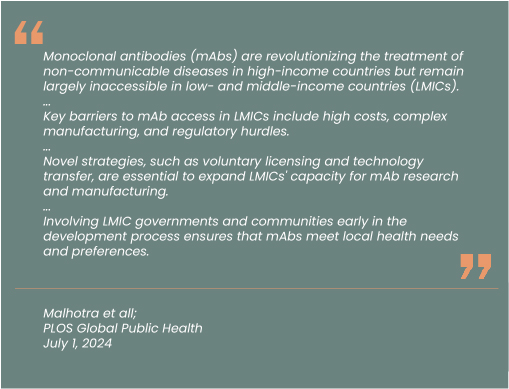July 22, 2024: Kigali, Rwanda and San Francisco, USA
In their recent paper (Malhotra et al 2024) Shelly Malhotra and colleagues provide an excellent distillation of the challenges surrounding equitable access to powerful monoclonal antibody - based (mAb) therapies in Low-Middle Income Countries (LMICs), despite their having been standard-of-care in higher income countries for decades. What distinguishes this article is that the authors take a deeper look into the issues that drive the well-known affordability barriers, to suggest enabling solutions that are both impactful and feasible. The content is weighted slightly more toward mAbs for emergent,infectious diseases (IDs) (for which outbreaks can be unpredictable and/or episodic), but many of the points are nonetheless equally relevant to mAbsfor non-communicable diseases (NCDs) for which epidemiological dynamics are more predictable.
The authors frame the underlying barriers to access as stemming from:
- Lack of commercial incentives to implement solutions that might improve accessibility (whether due to cost or availability)
- Manufacturing complexity
- Regulatory process complexity
To address these barriers, the authors identify several key levers and propose potential enabling solutions:
1. Increasing R&D and manufacturing innovation for optimized mAbs to reduce COGs (early 2000’s, $300/g, now around $100/g or less, could go below $50/g)
-
- Coordinating funding to cover end-to-end activities, including last mile logistics;
- Manufacturing process optimization – adopting continuous processes, moving from intravenous to subcutaneous formulations, cell line optimization, proof of concept smaller scale studies to help ensure process improvements are actually incorporated;
- Identifying and investing in ‘trailblazer’ mAbs that are already approved in HICs, but are not yet affordable in LMICs (i.e. starting with small-scale projects with biosimilars for NCDs – precisely what our company, Bio Usawa Inc., is proposing);
- Investing in innovative trial designs (‘Linking platform trial sponsors to local/regional mAb biosimilar manufacturers could allow an ‘end to end’ approach to support regional development and supply”).
2. Intellectual property, licensing and tech transfer to increase supply, reduce prices, and meet growing demand:
-
- Adopting voluntary licensing and tech transfer;
- Instituting supportive policy environments (e.g., aimed at self-sufficiency);
- Supporting local/regional R and D collaborations;
- Creating incentive mechanisms to urge companies to share patent rights, maybe for specific regions or formulations;
- Supporting expanded regional manufacturing capacity (hub and spokes model).
3. Regulatory pathways and strategies to facilitate mAb availability (less than 10% of national essential medicines lists in LMICs include Herceptin)
-
- Supporting regulatory collaboration and mutual recognition;
- Simplifying requirements for establishing biosimilarity (greater use of non-clinical testing, including use of biomarkers, especially when full dossier is available from originator).
4. Market shaping, de-risking and demand creation (to overcome fragmented market demand, unpredictable demand, affordability barriers)
-
- Obtaining governmental support in facilitating adoption into health systems; inclusion in guidelines, procurement lists, essential medicines lists, insurance policies;
- Enabling pooled procurement platforms;
- Generating more accurate demand forecasts and defining willingness-to-pay thresholds (committed funding via volume guarantees or procurement subsidies for products that are critically needed);
- Awareness - raising and advocacy.
Bio Usawa, Inc. embraces these points, which form the foundation of our mission to revolutionize healthcare access across Africa.

Bio Usawa, a company that is bridging the divide between the world’s leading healthcare markets and the growing demand for access to innovative biologic…
July 2025“The recent revelation that nearly 20% of tested chemotherapy drugs failed basic quality standards is more than just alarming—it is a global public heal…
July 2025"Our new strategic partnership opens the door to providing effective, affordable high-quality monoclonal antibodies to patients in Sub-Saharan Africa su…
July 2025